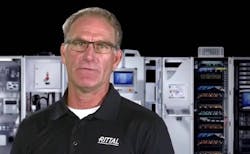Temperature Control Tips for Enclosures
Enclosures are one of the most commonly used pieces of equipment across industry. Because they house the automation electronics used to keep operations up and running, enclosures are critical components of any industrial automation strategy. And when it comes to selecting enclosures for use in high-temperature or other extreme environments, the decision-making process can become highly complex.
To learn more about this, we connected with Steve Sullivan of Rittal—a supplier of industrial and IT enclosures, racks, and accessories—for a recent episode of the “Automation World Gets Your Questions Answered” podcast.
Sullivan began our discussion by noting that the most common approach to keeping control enclosures cool in high temperature environments are, of course, fans or air conditioning units. As obvious as this may sound, he was quick to point out that these two enclosure cooling methods are used in opposite types of environments. The reason for this, he said, is because fans do not cool air.
“No matter how big the fans are, how fast they’re running, or how many you use, they only move the air. The temperature will be the same on the front side of the fan as on the back side,” Sullivan said. “So, in high-temperature applications, you need something that will cool the cabinet below the ambient temperature.”
One way to do this is to place the control enclosures indoors or in a climatized container and then use fans to bring the surrounding cool air into the enclosures. Sullivan noted that he has seen this method used effectively in extreme high-temperature applications in Texas.
When evaluating ambient air-cooling methods, Sullivan suggested comparing refrigerant-based systems to those that use a cooling medium like water or the Peltier effect (as applied in air conditioners or air-to-water heat exchangers).
“But you need to be aware of the limitations of these devices,” he cautioned. “For example, an air conditioner is a closed-loop system that usually has a maximum operating temperature in the 130-140 ºF range. For applications above this temperature range, you need to use an air-to-water heat exchanger, as water has 4,000 times the thermal capacity of air, so you could use this method in temperatures ranging from 150-163 degrees ºF.”
A key aspect of enclosure cooling method selection is to have your decisions driven by the most sensitive electronic devices housed in the enclosure. “Usually the specifications on these electronic devices will detail the cooling requirements and even the preferred enclosure type, in terms of protection ratings such as NEMA, UL, or IP. In such cases you need to gear the climate control to those specifications. And keep in mind that the enclosure and the cooling device will likely need to match in rating. For example, if you have a NEMA 4 enclosure and put a NEMA 12 filter fan on it, the panel would then de-rate to NEMA 12.”
Sullivan also advised keeping maintenance issues in mind as you go about making enclosure cooling decisions. “For air conditioning methods, remember that regular filter changes will be required. Air-to-water heat exchangers, on the other hand, require very little maintenance. Also consider the levels of dirt, dust, oils, and explosive or corrosive materials in the environment. And if the enclosure will be located outdoors, you may need to consider the effect of solar loading, which can tie into the color of enclosure you need to select. Consider temperature swings too, such as cool mornings, hot days, and cool nights. These kinds of temperatures swings can lead to condensation in the enclosure, which means you might need both a cooling device and a heating device to deal with those swings.”
Wrapping up our discussion of the numerous factors to be evaluated for control cabinet temperature control, Sullivan said that the best place to start is by having a good, basic understanding of what electronic products are to be used in the enclosure. Knowing how to effectively deal with the temperature requirements of these devices often comes down to basic physics, he said, but software can be a big help in this process. “I use the Rittal Therm 6.6 software, which can be downloaded for free online and used for any type of enclosure equipment, not just those from Rittal,” he said.
About the Author
David Greenfield, editor in chief
Editor in Chief

Leaders relevant to this article:
